Lecture 24 - Quasars and Active Galaxies (4/15/99)
 Expansion of the Universe --- | ---
Cosmology
Expansion of the Universe --- | ---
Cosmology

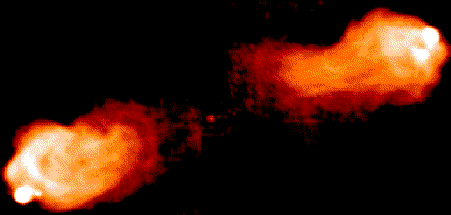 Reading:
Reading:
Chapter 23, 24 (ZG4)
Notes:
pages 96-101
The radio galaxy Cygnus-A (M87) as seen by the
VLA at 20cm.
(Courtesy
Phil Blanco/UCSD)
 |
Key Question: |
What are quasars?
|
|---|
 |
Key Principle: |
Accretion and Eddington Luminosity
|
|---|
 |
Key Problem: |
How do you generate 10^13 Lsun with
a galaxy nucleus?
|
|---|
Investigations:
- Redshift
- Why does the wavelength of light expand with the Universe?
- How is the redshift z of a galaxy related to the Doppler
shift?
- What is the characteristic distance c/H, or Hubble distance,
associated with the expansion?
- What is the characteristic timescale 1/H, or Hubble time,
associated with the expansion?
- What does H=60 km/s/Mpc imply for the age and scale of the Universe?
- What is a peculiar velocity and how does it affect the use
of the Hubble relation as a distance indicator?
- How can we measure a peculiar velocity?
- If the expansion velocity v is constant, what is the significance
of the timescale 1/H?
- If the Hubble constant H is constant, what is the form for the
expansion x(t)?
- Why is the current value of the Hubble constant, H_0, used instead of
just H?
- What do we mean by the Big Bang, and why need there not be
an explosion or center to account for an expanding universe?
- How is the redshift z related to the scale factor a
of the Universe, where r(z=0) = a*r(z) for some
physical distance r?
- The Universe at High Redshift (z > 0.1)
- What is the distance modulus for the Hubble distance (H=60) of
5000 Mpc?
- How bright would a supernove (M = -20) be at this distance?
- How bright would a bright cluster galaxy (M = -23) be?
- Is this brightness level easy to obtain?
- Why do some galaxies have very bright nuclei?
- Why are some galaxies unusually bright in the radio?
- Why do some galaxies have strong emission lines?
- Why do some galaxies show extreme star formation rates?
- The Radio Sky
- When did radio astronomy develop?
- What did Karl Jansky discover for the source of low-frequency
(167 MHz) celestial radio emission?
- What sorts of radio sources did Grote Reber find when he
pointed his backyard radio telescope skyward in 1936?
- What wartime deveopments allowed radio astronomy to leap forward
after WWII?
- Why is synchrotron emission strong in our galaxy?
- Why are supernova remnants bright in radio emission?
- Why do some galaxies have huge radio luminosities?
- Radio Galaxies
- Why are radio galaxies often referred to as classical radio doubles
?
- What parts of a radio galaxy do core, jet, hot
spot, and lobe refer to?
- Where is the optically identified galaxy located with respect to the
radio emission?
- At what rate must mass be converted to energy (E=mc2) to
supply the observed power of 1038 Watts for Cygnus-A?
- How much total mass has been converted to produce the total energy
of 1052 J? What lifetime does this imply?
- Why does the morphology suggest that the energy is generated in the
center of the galaxy and transported to the lobes by the relativistic
jets?
- Why do we know there are relativistic electrons involved?
- Why do we believe that supermassive black holes are involved?
- At what rate must stars be devoured to supply the energy needs of
Cygnus-A?
- Quasars
- Why do some double radio sources appear to have "quasi-stellar
objects" at their centers and not galaxies?
- What does the term quasar mean?
- What did Maarten Schmidt discover in 1962 when he finally identified
the mysterious absorption lines in 3C273 and 3C48?
- What is the absolute magnitude of 3C273 if it has m_v = 13 and is at
a redshift z = 0.16 (d = 800 Mpc)? Why is this surprising?
- What is the likely source of this emission, given that it is observed
to originiate within a parsec or so of the core?
- What is the mass of the black hole needed to supply the luminosity of
1013 Lsun at the Eddington luminosity?
- Central Engine: Supermassive Black Holes
- How do you build a 108 Msun black hole at the center of
a galaxy?
- Why might the jet axis be aligned with an angular momentum axis of
an accretion disk?
- Why do we expect magnetic fields to be involved?
- What is the Schwarzschild radius of a 108 Msun black hole?
- What magnetic field strengths are needed near a black hole to supply
the Blandford-Znajek power
P ~ B2 RS2 c
- What is the energy density for a magnetic field of B gauss?
Why do we use cgs units here?
- What do we mean by equipartition of magnetic and particle
energy?
- What magnetic field strengths are implied by an energy of
1059 ergs in a radius of 9 kpc?
- How does the relativistic jet carry momentum? What is the rate of
momentum transfer for jet power P?
- If the hot-spot area is pi*R^2, and the IGM density is rho, then
what is the advance speed implied for R=9 kpc and P=10^38 W, if
n ~ 1/m^3 in the IGM?
- What is the time needed to advance 50 kpc at these speeds, and how
does it compare to our luminosity lifetime?
- How does our supermassive black hole picture fit together will all
these parts?
- Gravitational Lenses
- Why is light bent near a black hole? Should it be bent near other
masses?
- Why is the characteristic scale for lensing the Schwarzschild radius?
What is the Schwarzschild radius for a 10^12 Msun galaxy?
- How many R_S are needed to deflect light by 1"?
- Why are point sources behind galaxies "imaged" into multiple (2 or 4)
magnified images?
- Why are background extended objects lensed into Einstein rings?
- What does lensing tell us about the mass of the lensing galaxy and
the scale of the lens? How can this be a distance indicator?
- Do clusters of galaxies lens background galaxies also?
- Large Scale Distribution of Galaxies
- Are galaxies uniformly distributed about the universe?
- What are clusters of galaxies?
- What are the members of the Local Group of galaxies?
- How do we get the 3rd dimension (distance) in our maps of
large-scale structure?
- Why do clusters look "big" along the redshift dimension (ie. "finger
of God")?
- What are voids in the galaxy distribution?
- What are walls and filaments?
- What is a supercluster?
- What does the clustering of galaxies tell us about the universe?
- Clusters of Galaxies
- Are clusters like Virgo or Coma gravitationally bound objects?
- How is the velocity dispersion calculated?
- How are the 3-D and radial velocity dispersions related?
- What is the binding energy of a uniform density spherical cluster
of radius R and mass M?
- What does the virial theorem tell us the velocity dispersion
is of this cluster?
- Given the radial velocity dispersion what is the virial mass
of a cluster?
- What is the virial temperature of gas in a cluster of
R=1.5 Mpc and M=10^15 Msun?
- Why is this gas bright at X-ray wavelengths?
Large Scale Structure of the Universe in Outline
- Active Galactic Nuclei
- Some galaxies have extremely luminous nuclei, often
outshining the rest of the galaxy.
- These objects are called active galactic nuclei.
The Milky Way appears to have such an active nucleus.
- Some active galaxies, like our Milky Way, appear to be
powered by supermassive black holes at the center.
- Other types of active galaxies show evidence of widespread
star formation in the inner hundreds of parsecs.
- Some of these star-forming galaxies, called starbursts,
can also be very luminous from large numbers of O and B stars
and H II regions.
- Supernovae in the starburst regions will also produce large
amounts of energy.
- Radio Galaxies
- Radio astronomy began in the 1940s using WWII radar technology.
- Many of the brightest radio sources are associated with distant
galaxies.
- The first crude maps showed a "double" structure to these radio
galaxies.
- The radio emission comes from a region much larger than the optical
galaxy - often greater than 1 Mpc in extent.
- The emission is synchrotron radiation from relativistic electrons
moving in weak magnetic fields.
- This jets of emission extend from a central nucleus to
hotspots at the far edges of the lobes.
- The jets feeding the electrons outward to the lobes from the
central black hole (or other energy source).
- The total radio luminosity from synchrotron in powerful radio galaxies
is 10^36 to 10^38 Watts (10^10 to 10^12 Lsun).
- The total energy contained in the lobes is about 10^53 J, equivalent
to 10^6 Msun c^2 of mass-energy! This could be obtained over the
typical 10^6 year lifetime of a radio source by conversion of 1 Msun
per year into energy.
- The likely source for this energy is a supermassive black hole of
mass 10^6 to 10^8 Msun. Such a monster could gravitationally extract
10% of the rest mass energy of 10 Msun/yr of fuel to supply the needed
power.
- Some of the largest radio galaxies extend out to several Mpc on
either side of the nucleus.
- Some radio sources show evidence of interaction with intergalactic
gas, being swept backward as the galaxy moves forward at
a few hundred km/s.
- Quasars
- Some bright radio sources seemed to be not associated with
galaxies but with stellar like objects.
- These are quasars, or "quasi-stellar radio sources".
- The optical spectra of quasars showed strange lines
which did not seem to correspond to known elements.
- Maarten Schmidt at Palomar Observatory realized in 1962 that these
were highly redshifted Balmer lines of hydrogen!
- This was controversial since these redshifts (z=0.16 for
3C273 and z=0.37 for 3C48, the two first discovered) indicated
extreme distances and thus huge luminosities (10^15 Lsun).
- Quasars were soon found with redshifts z > 1. These were
at that time the most distant objects known.
- Currently, the most distant quasar known has a redshift
z > 5!
- Some quasars are were discovered that did not have any radio
emission - these were dubbed QSOs, or "quasi-stellar objects".
- Some of the quasar emission may be beamed, like a
searchlight.
- Gravitational Lenses
- For lensing by a galaxy (10^12 Msun) instead of a star (1 Msun),
the splitting are an arcsecond or more - easily seen!
- The first lens, a double quasar, was found in 1979.
- Currently, there are over 30 gravitational lenses known.
- There are a number of gravitational lens surveys being carried out
that will greatly increase the number of known lenses in the next
few years.
- Gravitational lenses magnify the background galaxy or QSO, acting
as a gravitational telescope.
- The different light ray paths that correspond to the different images
have different lenghts, so there are relative time delays that can
be seen if the source is variable.
- If the time delays can be measured in addition to the image
separations and relative magnifications, then the distance to
the lens and source can be separated out from the mass of the
lens.
- This will lead to a measurement of the Hubble constant independent
of the standard distance ladder.
- Clusters of galaxies (10^15 Msun) can also act as gravitational
lenses, distorting and magnifiying background galaxies and QSOs.
The image separations are larger (>10") and usually result
in arcs as extended background galaxies are smeared out
and highly magnified.
- Cluster lenses are an important tool for measuring the mass in
clusters.
- Luminosity Function of Galaxies
- What is a luminosity function? How does it describe
the number density of galaxies of a given luminosity per Mpc^3?
- What is the Schechter luminosity function?
- What is meant by a L* galaxy?
- At low luminosities, why does the Schechter function predict
a diverging (infinite) number of faint galaxies, yet a finite
total luminosity density?
- Why do we measure distances in the units of h^-1 Mpc,
where H0 = 100 h km/s/Mpc?
- About how many galaxies of L* or brighter are there per
cubic Mpc?
- Large Scale Distribution of Galaxies
- Are galaxies uniformly distributed about the universe?
- What are clusters of galaxies?
- What are the members of the Local Group of galaxies?
- How do we get the 3rd dimension (distance) in our maps of
large-scale structure?
- Why do clusters look "big" along the redshift dimension (ie. "finger
of God")?
- What are voids in the galaxy distribution?
- What are walls and filaments?
- What is a supercluster?
- What does the clustering of galaxies tell us about the universe?
- Clusters of Galaxies
- Are clusters like Virgo or Coma gravitationally bound objects?
- How is the velocity dispersion calculated?
- How are the 3-D and radial velocity dispersions related?
- What is the binding energy of a uniform density spherical cluster
of radius R and mass M?
- What does the virial theorem tell us the velocity dispersion
is of this cluster?
- Given the radial velocity dispersion what is the virial mass
of a cluster?
- What is the virial temperature of gas in a cluster of
R=1.5 Mpc and M=10^15 Msun?
- Why is this gas bright at X-ray wavelengths?
Interacting Galaxies
Computer simulations of the interactions between galaxies have been an
important development in our understanding of this process. In essence,
model galaxies are set up with "stars" (particles) and "gas" (fluid elements),
and then moved along a grid interacting via Newtons laws and hydrodynamics.
Early simulations demonstrated the production of "tidal tails". Current
state-of-the art simulations are showing the extent of the influence of
interactions on the evolution of galaxies in our universe.
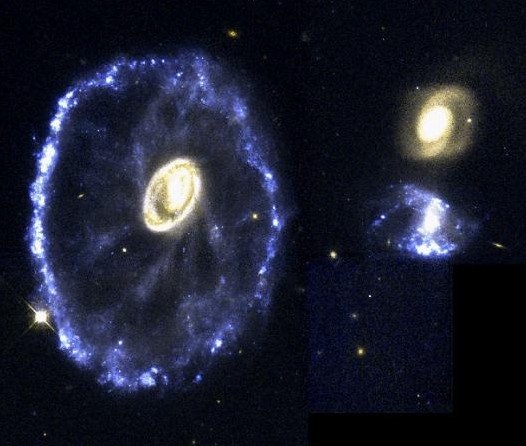
The Cartwheel Galaxy, courtesy
HST/STSCI
The above image is from the Hubble Space Telescope, and shows a galaxy
that has been disturbed by what was probably a direct hit by the (also
disturbed) small blue galaxy on the right. The ring and spokes are
what is left of the disks of the galaxies, with shock-induced star formation
going on in the ring, and some gas accumulating in the center of the remnant.
Some galaxy interaction resources:
Supermassive Black Holes at the Centers of Galaxies
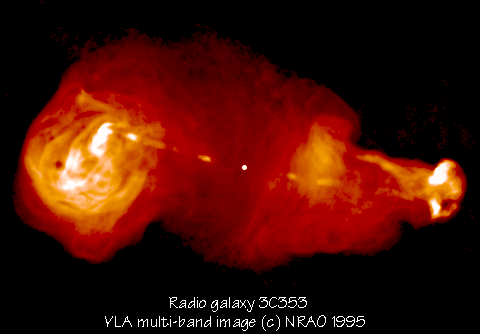
Radio galaxy 3C353 multi-band image from VLA,
courtesy Alan Bridle (NRAO).
Some internet links to quasar and radio galaxy sites:
Gravitational Lenses
One reason we believe that quasars really are very distant is because
sometimes we see them lensed by a distant galaxy between us and the quasar!
A galaxy in front of a background galaxy or quasar will gravitationally
lens the background source by the bending of the light rays. Since
galaxies are 10^12 times more massive than stars, the image splittings are
arcseconds instead of 10^-6 arcseconds (angle proportional to the square-root
of the mass).
I am currently involved in the Cosmic Lens All-Sky Survey (CLASS)
which is currently mapping around 10000 radio sources looking for indicences
of multiple images indicative of lensing. So far, we have found 5 new lenses
and a large number of candidates that we are checking whether they are lenses.
For a description of CLASS and the lenses we have found, see my
CLASS Home Page.
Large clusters of galaxies, which contain thousands of galaxies and
total masses of 10^14 to 10^15 Msun within a radius of several Mpc, also
act as powerful gravitational lenses. Background galaxies and QSOs are
magnified and distorted into arcs by the lensing action of the cluster.
The Hubble Space Telescope has taken some spectacular pictures of gravitational
lensing by the cluster
Abell 2218
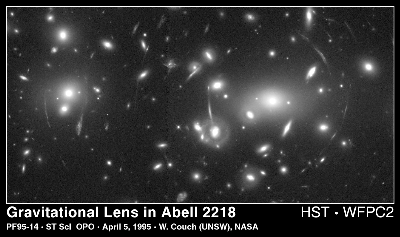
For more on the gravitational lenses I found in my VLA-based radio
survey, see the Penn CLASS Page.
Large Scale Surveys of Galaxies
There are a number of large-scale surveys aimed at measuring redshifts
of a large number of galaxies and thus delineating the structure that we
see in the Universe around us.
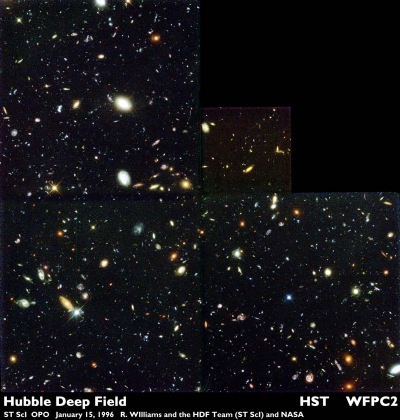
The Hubble Deep Field. Courtesy
HST/STSCI
Though not a redshift survey, the Hubble Deep Field (HDF) is also
revolutionising our understanding of the distant universe, as we can
see galaxies as they were during the early phases of life.
 Prev Lecture ---
Prev Lecture ---
 Next Lecture ---
Next Lecture ---
 Astr12 Index ---
Astr12 Index ---
 Astr12 Home
Astr12 Home
smyers@nrao.edu
Steven T. Myers
 Expansion of the Universe --- | ---
Cosmology
Expansion of the Universe --- | ---
Cosmology

 Expansion of the Universe --- | ---
Cosmology
Expansion of the Universe --- | ---
Cosmology

 Reading:
Reading: 






 Prev Lecture ---
Prev Lecture ---
 Next Lecture ---
Next Lecture ---
 Astr12 Index ---
Astr12 Index ---
 Astr12 Home
Astr12 Home